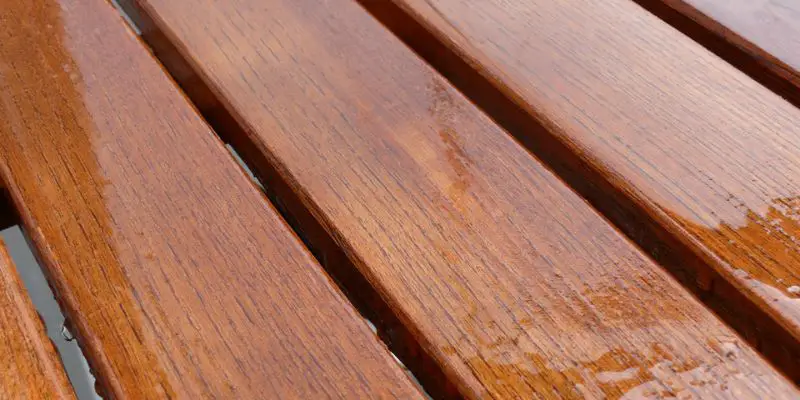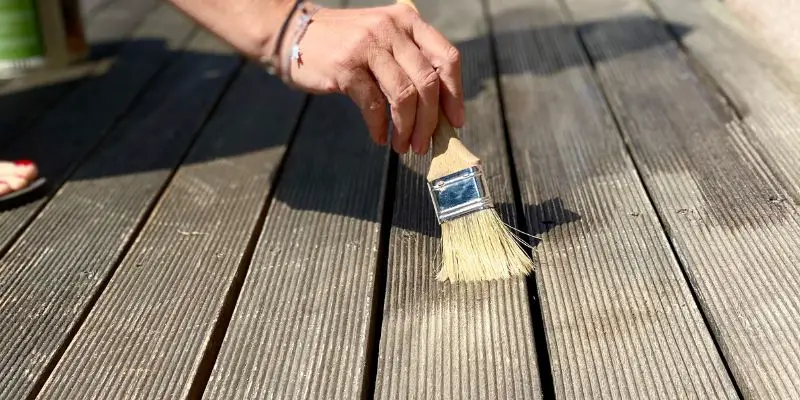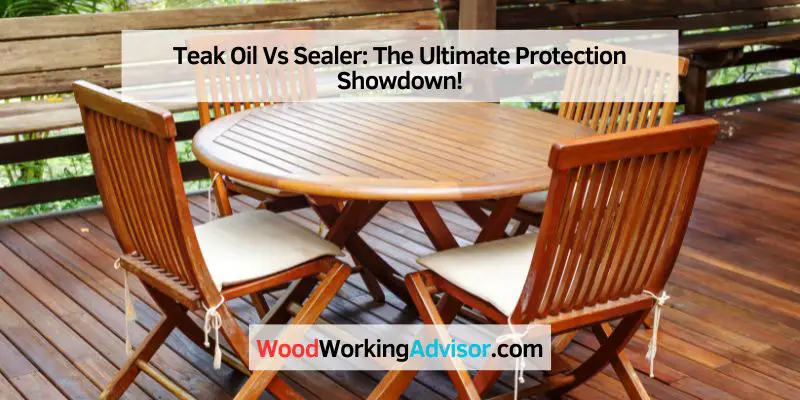Teak oil enhances the natural beauty of teak wood, while sealer provides a protective barrier against damage. Teak oil brings out the richness of the wood, while sealer shields it from harm.
Teak oil and sealer play vital roles in preserving and maintaining teak wood furniture and surfaces. Teak oil, known for its ability to penetrate deep into the wood, enhances the natural beauty of teak by bringing out its rich color and grain patterns.
This oil nourishes the wood, keeping it strong and preventing it from drying out. On the other hand, a sealer creates a protective barrier on the surface, guarding against moisture, UV rays, and other potential damage. It helps to prevent stains, discoloration, and weathering, ensuring the longevity of teak wood. Understanding the differences between teak oil and sealer is important to choosing the best option for your teak wood needs.
Teak Oil
Teak oil is a widely used product for maintaining and enhancing the beauty of teak wood. It is specifically formulated to penetrate the surface of the wood, protecting it from moisture and harsh environmental conditions. In this section, we will discuss the explanation, pros and cons, as well as the application method and frequency of using teak oil.
Explanation Of Teak Oil
Teak oil is a type of wood finish specifically designed for teak wood, which is known for its natural durability and resistance to rot. It is composed of a combination of natural oils and solvents that deeply penetrate the wood, nourishing it and providing a protective barrier against moisture.
Pros And Cons Of Using Teak Oil
When it comes to using teak oil, there are several advantages and disadvantages to consider:
| Pros | Cons |
|---|---|
|
|
Application Method And Frequency
Applying teak oil is a relatively straightforward process. Before starting, ensure that the teak wood is clean and free from any dust or debris. Follow these steps:
- Use a clean, lint-free cloth or brush to apply the teak oil evenly over the surface of the wood.
- Allow the oil to penetrate the wood for approximately 15 minutes.
- Wipe off any excess oil with a clean cloth to prevent a sticky residue.
- Allow the wood to dry completely before using the furniture or applying additional coats of teak oil.
Regarding the frequency of application, it is recommended to reapply teak oil every 3-6 months, depending on the exposure of the teak wood to sunlight and weather conditions. Regular maintenance will help ensure the continued protection and beauty of your teak furniture.
Overall, teak oil can be a great choice for preserving the natural beauty of teak wood. However, it is important to consider the pros and cons, as well as the application method and frequency, to make an informed decision about whether teak oil is the right option for your specific needs.

Sealer
Sealer and teak oil serve different purposes when it comes to protecting and enhancing the beauty of your teak furniture. While teak oil penetrates the wood to nourish and bring out its natural color, sealer acts as a protective barrier against moisture and UV damage.
Choose the right option based on your specific needs and desired outcome for your teak furniture.
Explanation Of Sealer
When it comes to protecting and enhancing the appearance of your teak furniture or decking, using a sealer can be a great choice. A sealer is a type of protective coating that penetrates deep into the wood to create a barrier against moisture, UV rays, and other damaging elements. Unlike teak oil, which nourishes the wood, a sealer forms a protective layer on the surface, providing an extra level of defense.
Pros And Cons Of Using Sealer
Using a sealer for your teak furniture or decking has its own set of advantages and disadvantages. Let’s take a closer look at the pros and cons:
| Pros | Cons |
|---|---|
|
|
Application Method And Frequency
Applying a sealer to your teak furniture or decking requires careful consideration of the right application method and frequency to ensure optimal results. Here is a brief guide:
- Prepare the surface: Before applying the sealer, make sure the teak is clean and dry. Remove any existing finishes or residues using a teak cleaner and let the wood dry thoroughly.
- Choose the right product: Select a high-quality teak sealer that is suitable for your specific needs, taking into account factors such as indoor or outdoor use and the desired level of gloss.
- Apply the sealer: Use a brush or a rag to apply the sealer evenly on the teak surface. Work in small sections and make sure to cover all areas, including edges and corners.
- Allow drying time: Let the sealer dry completely between coats. Follow the manufacturer’s instructions for the recommended drying time.
- Multiple coats: Depending on the product, you may need to apply multiple coats of sealer to achieve the desired level of protection and finish. Sand lightly between coats for a smooth surface.
- Maintenance and reapplication: The frequency of reapplication depends on factors such as weather conditions and usage. Generally, it is recommended to reapply the sealer every 1-2 years or as needed.
By following these guidelines, you can ensure that your teak furniture or decking receives the maximum benefits from using a sealer, keeping it well-protected and looking its best for years to come.
Comparison
The comparison between teak oil and sealer is essential to understand their differences in protecting teak furniture, as well as their longevity and maintenance. Let’s delve into the details to help you make an informed decision for preserving the natural beauty of your teak furniture.
Differences Between Teak Oil And Sealer
Teak oil and sealer differ in their composition and application methods, leading to distinct effects on teak furniture. Here’s a breakdown of their differences:
- Composition: Teak oil is typically a blend of oils, such as linseed or tung oil, which enhances the natural color of teak and provides some degree of protection against moisture and UV rays. On the other hand, a sealer is a clear or colored solution that forms a protective layer on the surface of teak furniture, shielding it from damage caused by water, sunlight, and environmental pollutants.
- Application: Applying teak oil requires a surface preparation step, such as cleaning the teak furniture with a teak cleaner and allowing it to dry. Once prepared, the oil is applied using a brush or cloth, following the wood grain, and excess oil is wiped off after a few minutes. In contrast, applying a sealer involves cleaning the surface, ensuring it is dry, and then using a brush or cloth to evenly coat the teak furniture. Sealer application does not require wiping off excess solution.
Effectiveness In Protecting Teak Furniture
The primary concern when choosing between teak oil and sealer is their effectiveness in protecting teak furniture from various elements. Here’s a closer look at their protective abilities:
| Teak Oil | Sealer | |
|---|---|---|
| Moisture Protection | Provides some level of protection against moisture due to its oil-based formulation. | Forms a durable barrier that effectively repels moisture and prevents it from penetrating the wood. |
| UV Protection | Offers limited UV protection, slowing down the natural graying process of teak. | Offers effective UV protection, preventing teak from turning gray and reducing the risk of sun damage. |
| Color Enhancement | Accentuates the natural color and grain pattern of teak, enhancing its aesthetic appeal. | Preserves the original color of teak while providing a glossy or matte finish, depending on the sealer type. |
Longevity And Maintenance
When it comes to longevity and maintenance, teak oil and sealer have different requirements and durability. Consider the following:
- Longevity: Teak oil may require re-application every few months to maintain its protective properties, especially when constantly exposed to outdoor elements. On the other hand, sealers tend to offer longer-lasting protection, with some high-quality sealers lasting up to two years before requiring re-application.
- Maintenance: Maintaining teak furniture treated with oil involves regular cleaning with a teak cleaner and re-oiling as needed. It’s crucial to remove any mildew or dirt buildup to prevent the growth of fungi. Sealer-treated furniture requires minimal maintenance, usually involving gentle cleaning with a mild soap and water solution.
Now that you understand the differences between teak oil and sealer, as well as their effectiveness in protecting teak furniture and maintenance requirements, you can make an informed decision based on your specific needs and preferences.

Frequently Asked Questions On Teak Oil Vs Sealer
Should the Teak Be Oiled Or Sealed?
Teak should be oiled or sealed to protect it from weathering and maintain its natural color. The oil or sealer creates a barrier against moisture and prevents cracking or drying out. Regular application is recommended to keep teak furniture looking beautiful and extend its lifespan.
Is Teak Oil The Same As Teak Sealer?
Teak oil and teak sealer are not the same. Teak oil is used to enhance the natural beauty of teak wood, while teak sealer provides a protective layer against UV rays and water damage. Use teak oil for aesthetics and teak sealer for protection.
When Not To Use Teak Oil?
Do not use teak oil when the wood has a protective finish, as it may not absorb properly. Avoid it on wood with a high moisture content or in humid environments, as it could promote mold and mildew growth. Additionally, teak oil should not be used on composite wood or painted surfaces as it may not adhere correctly.
What Is The Best Finish For Teak?
The best finish for teak is teak oil. It enhances the natural beauty of the wood, protects it from UV rays, and prevents it from drying out. It’s easy to apply and provides a long-lasting, water-resistant seal.
Conclusion
Both teak oil and sealer are effective options for protecting and enhancing the appearance of teak wood. While teak oil penetrates the wood to nourish and maintain its natural color, sealer creates a protective layer on the surface. So, choose the option that best suits your preferences and the level of maintenance you are looking for.
Both options will provide long-lasting protection and enhance the beauty of your teak furniture or surfaces.


